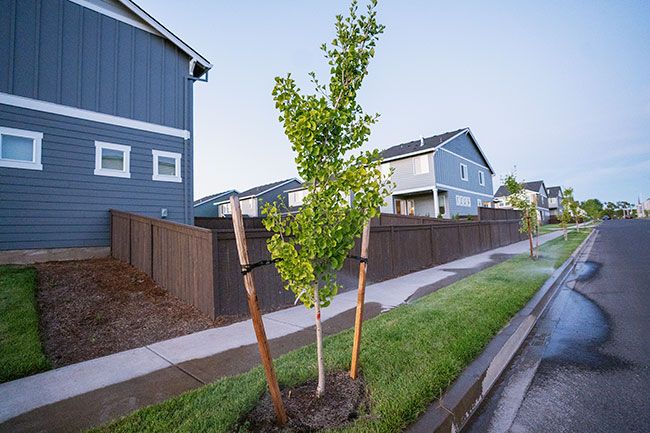Tree maintenance is up to homeowners

McMinnville’s Landscape Review Committee has noticed confusion among community members over the care of “street trees” and wants to get the word out that watering and maintenance are the responsibility of the property owner.
Street trees are defined by city code as “located within the street right-of-way,” the majority of which are neighborhood trees planted between the sidewalk and curb.
When a new development or subdivision is constructed, planted trees are the responsibility of the builder for one year, then maintenance falls on the property owner.
“Typically there’s a maintenance period, a guarantee for a period of time that the original installer is responsible for replacing trees,” Senior Planner Tom Schauer said. “Once somebody buys a house, I think sometimes there’s not a lot of awareness that those are up to the property owner to maintain.”
Committee vice-chair Patty Sorensen worries there’s a disconnect between city rules and public knowledge.
“My big concern is that folks don’t know what their responsibilities are,” Sorensen told the News-Register. “I’ve never had anyone tell me what the responsibility is for the street tree.”
City code states that street tree maintenance includes “necessary watering, weeding, pruning and replacement.” Property owners are required to prune to allow at least eight feet of clearance for pedestrians.
While watering is the primary need, Sorensen has noticed other maintenance issues that could harm trees.
Recently planted trees often have bamboo supports and ribbons left over from transport that need to be removed before growth is affected, Sorensen said.
“Those are there to help the transport of the tree,” she said of ribbons and supports. “What happens is the tree grows and the ribbon grows into the tree and scalds it and creates cracks, and that’s where you get bugs, insects, viruses, all kinds of things in there and the tree grows irregularly.”
Property owners should also remove new growth from the base of the tree that emerges after planting, Sorensen said.
“That is sucking away energy from the tree.”
Another maintenance aspect that has been lost in translation is the requirement to obtain a permit for heavy pruning, removal and replacement of street trees.
“A lot of folks, I don’t believe, understand that when a tree dies, you don’t just cut it down,” Sorensen said. “That is under a city ordinance, and you need to come (to planning) and get the whole process going.”
Property owners are required to fill out an application with the planning department, which is then reviewed by the landscape committee. The committee is currently working on changes to city code which will ease the requirements slightly, allowing for some cases to be reviewed and approved by city staff without going before the committee, Schauer said.
“We’re working on kind of defining two classes of simpler permits that would be done administratively.”
The committee is hoping to present the changes to city council in August, Schauer said.
The rules around maintenance and replanting aren’t just city rules, they are crucial to maintain a healthy environment, Sorensen said.
“When houses were built, we took away land that was breathable and we replaced it with asphalt, concrete, all of that and the trees are a part of maintaining a healthy environment for us to be living in,” she said. “You keep cutting those down and we’re not going to have the environment that we’re going to want.
“The more trees, the better it is.”












Comments
sisinmac
And when these trees get big enough, they lift up the sidewalks in front of your house, which causes a tripping hazard to people walking on the sidewalks, and as I understand it, the homeowner is liable for any injury caused by these sidewalk lifting issues. Does anyone else feel this is unfair?
tagup
Maybe if the trees fit the planting area a little better. Planting maples that will grow to 50’ in a 3’ area between the sidewalk & street is eventually going to cause problems. Yet my understanding is that’s what the city recommends.
Local Yokel
One long holiday weekend the trees that were causing the sidewalk to raise up and trip people walking by, just disappeared! It was the craziest thing!! Neither my neighbor nor myself had any idea what happened to the trees or how the sidewalk leveled itself back out but the neighborhood was sure happy!
Boukerduck
Replying to sisinmac….. And what if the builder/developer didn’t follow the rules of the city with what type of tree they planted and how it was planted? Happening all over town…..
tagup
Not sure I can accept that builders & developers are responsible for the numerous locations of trees pushing up concrete all over town. The classic example is third street.
BigfootLives
Yep, contractors want 2 things. People to buy their houses and the city to sign all of their documents. If the city didn’t sign off on them they wouldn’t be there.
Rds
It has always bothered me that the city mandates putting in these trees and sidewalks but then forces the home owners to provide maintenance. When these trees get too large for the strip they are put on and then lift the sidewalk the city then forces the owner to spend thousand of dollars to cut the tree and replace the sidewalk. Since they are forcing these on the owners it seems to me it should be the city that repairs these walks and trees. And in a few years they will make you pay to get the tree removal plan permit.
Jean
wishing the city would remove my gumball maple tree next to my sidewalk. It's pushing up the sidewalk and it constantly drops those spikey gumballs that are a joy to walk on barefoot.
bonnybedlam
I learned about all of this the hard way a few years ago when code enforcement busted me for unpruned plum trees and then the city said I couldn't prune them the way the arborist I hired recommended. They're my trees and my responsibility, but I'm not allowed to do what's best for them because of an arbitrary rule that doesn't take individual tree needs into account. At least they're small so the roots don't tear up the sidewalk. But they've also been banned under new codes so when they die I won't be allowed to put in new ones.
CubFan
RDS... I completely agree. Hardly seems fair that the city dictates what trees can be planted, then the homeowner is responsible for maintenance including watering and pruning. When/if sidewalks buckle... that's on the homeowners too.
Boukerduck
@tagup…. We were speaking about residential streets, not commercial areas.
tagup
Point taken regarding third street… but you can go to almost any neighborhood with mature trees and find sidewalk issues… I doubt they are all due to developers/ builders going against city codes.
sbagwell
My gripe is that the city participates in sidewalk repairs in commercial districts, but not in residential districts like mine, where root damage is severe almost everywhere. If you do your very best and a tree dies on your watch anyway, you have to buy a permit to cut it down, buy a permit to replace it, grind the roots down to a full foot below the surface, let the city choose the replacement tree, install a barrier to prevent it all from happening again, and cover all the removal, replacement, barrier and permit costs on your own. So who decided to plant towering maples in narrow spaces in front of our houses 30 years ago, before we moved in? Seems he, she or it holds more responsibility for the damage than those of us who moved in long after the fact.
Steve